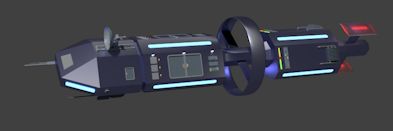I'm having a conversation on another forum about this, and it occurred to me that the details could be generally valuable. The calculations for relativistic travel are detailed on this site. I've extracted the essential equations, to save time:
The rocket equations are
t = objective time
c = speed of light
a = acceleration
d=distance
T = subjective time
u = tau factor
To calculate absolute elapsed time given acceleration and subjective time
t = (c/a) sinh(aT/c)
To calculate absolute elapsed time given acceleration and distance
t = sqrt[(d/c)2 + 2d/a]
To calculate distance given acceleration and subjective time
d = (c2/a) [cosh(aT/c) - 1]
To calculate distance given acceleration and objective time
d = (c2/a) (sqrt[1 + (at/c)2] - 1)
To calculate velocity given acceleration and subjective time
v = c tanh(aT/c)
To calculate velocity given acceleration and objective time
v = at / sqrt[1 + (at/c)2]
To calculate subjective time given acceleration and objective time
T = (c/a) sinh-1(at/c)
To calculate subjective time given acceleration and distance
T = (c/a) cosh-1 [ad/c2 + 1]
To calculate instantaneous tau given acceleration and subjective time
u = cosh(aT/c)
To calculate instantaneous tau given acceleration and objective time
u = sqrt[1 + (at/c)2]
To calculate instantaneous tau given acceleration and distance
u = ad/c2 + 1
The rocket equations are
t = objective time
c = speed of light
a = acceleration
d=distance
T = subjective time
u = tau factor
To calculate absolute elapsed time given acceleration and subjective time
t = (c/a) sinh(aT/c)
To calculate absolute elapsed time given acceleration and distance
t = sqrt[(d/c)2 + 2d/a]
To calculate distance given acceleration and subjective time
d = (c2/a) [cosh(aT/c) - 1]
To calculate distance given acceleration and objective time
d = (c2/a) (sqrt[1 + (at/c)2] - 1)
To calculate velocity given acceleration and subjective time
v = c tanh(aT/c)
To calculate velocity given acceleration and objective time
v = at / sqrt[1 + (at/c)2]
To calculate subjective time given acceleration and objective time
T = (c/a) sinh-1(at/c)
To calculate subjective time given acceleration and distance
T = (c/a) cosh-1 [ad/c2 + 1]
To calculate instantaneous tau given acceleration and subjective time
u = cosh(aT/c)
To calculate instantaneous tau given acceleration and objective time
u = sqrt[1 + (at/c)2]
To calculate instantaneous tau given acceleration and distance
u = ad/c2 + 1



